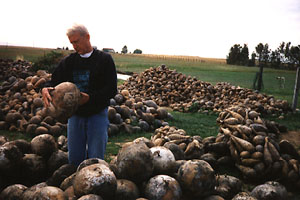 |
||||||||||||
|
|
||||||||||||
 |
||||||||||||
| Technology can be invoked to insure that modern 5-string banjos come off the luthier's bench in a fairly consistent manner. That is ,the previous instrument will sound and respond to the player's touch much like the one currently under construction. Also, it can be predicted that the same sound and response will evidence themselves in an instrument produced a year from now, assuming the design and level of production technology remain constant. | ||||||||||||
 |
Consequently, the banjo's design and the choice of materials that comprise it can be manipulated by the builder to produce an instrument that produces the most pleasing sound and satisfying response (according to the builder) in a particular tuning or range of tunings. To sum up: the builder can mold wood, plastic, metal, and wire to produce an object that responds in a predictable, predetermined manner. Of course, an individual player can make the banjo sound quite different from another player, but the instruments themselves remain relatively constant. | |||||||||||
| Such is not the case with the fretless, gourd banjos I build. In an attempt to roughly reproduce instruments which were made by 17th and 18th century African Americans living in the New World, I have adopted a philosophy of instrument building that is African in nature. From this point of view, the general form of the instrument is dictated by tradition. However, the specific size and shape are determined by the materials used. It's expected that each instrument will have its own voice resulting from the collaboration of instrument, musician, and a chosen relative tuning. | ||||||||||||
| The foregoing is a rather feeble attempt to prepare you for the task of getting to know your banjo. Since I, as the builder, find it impossible to mold or modify gourds, wood, skin and gut so as to produce the same instrument over and over, each banjo comes off the bench with its own individual potential. The instrument's voice is hidden, waiting to be discovered. You, as the musician, must bear a good deal of the responsibility for discovering that voice as your particular style of playing and way of hearing music are large ingredients in the mix of elements that produce that banjo's voice. |  | |||||||||||
| Besides the qualities that
you bring to play there are many other variables at work which help
determine the banjo's voice: the gourd's size and shape, the thickness of
the gourd, the texture of the gourd's interior surface, and the size and
shape of the head opening. Now, add to this the variables that exist in
the thickness and curing process of the skin head as well as the fact that
necks come in different sizes, shapes, and are made from different kinds
and combinations of wood. This situation is further complicated when it's
understood that banjo players are very apt to play when and where they
want. As these instruments move form one environment to another
(especially when changes in humidity are encountered) not only is tone and
volume affected but also string action. Coming to grips with all of this
may seem not much more complicated than dealing in human relations. It's
really not all that complicated. Here are a few suggestions and pointers that may help you find your banjo's voice. It might be helpful to know that I set up a gourd banjo by placing the bridge in the approximate middle of a tight head and perpendicular to the fingerboard. The gauge strings I have chosen seem to produce good results for tunings in the C to F# range with a 26" string length and the F to G range with a 23" string length. The variables you have to work with are bridge placement, bridge height and thickness, string gauge, string tightness, and head tightness. By far the easiest to work with are bridge placement, bridge height and string tightness. To start, I suggest you place the bridge in the middle of the head and tighten the strings to a C or D tuning. Then, retune the banjo every few hours for a couple of days until everything stretches out and the banjo holds its tune. Next, move the bridge up and down the strings until you find the place where you think the banjo sounds best. At this point, experiment with different tunings. It's almost certain that you will find a particular tuning that your banjo responds to best. You'll hear it as well as feel it as you hold the instrument. I wouldn't go any higher than a G tuning for fear of breaking a string. Most players find their banjos sound best in the D to F range. Next, check the string action. If it doesn't suit you, a taller or lower bridge can be fitted. Sanding bridges to different thicknesses can also affect the tone. Slanting the bridge on the head may make the banjo easier to play. This alters the way chords fall on the fingerboard and may make certain chords easier for you to reach. High humidity may cause the head to loosen and slump in the area under the bridge. If your banjo has bead tighteners they can be employed to tighten the head somewhat. However, most players find the best way to deal with this problem is to simply carry several bridges of different heights and replace the current bridge with a taller one. With string action restored, you can retune if necessary and you're back playing in a few seconds. Most players today assume that a tight head is a prerequisite of a good sounding banjo. In my opinion, this isn't necessarily true for gourd banjos. One of the best sounding gourds I've ever heard was played with a very loose, sagging head during a downpour in North Carolina. If you are a diehard tinkerer, you might want to experiment with strings of different gauges. This can be expensive and time consuming, but the results might be better tone and a string tension that better matches the energy level of your picking hand. I can assist you in selecting other strings as I carry a full range of Purr'll Gut Strings. I think it helps keep the banjo sounding better if the bridge is laid flat on the head between playing sessions. This takes a little tension off the strings and gives the head a chance to rebound and flatten out. Sometimes you may find yourself with your banjo tuned to its best voice, let's say D or F, and you want to play with others who are playing in G or A. Tuning up will probably result in broken strings. The easiest solution is to slide the bridge toward the peghead until the tuning you're aiming for is reached. This could be anywhere from 1 to 3 inches. You'll have to adjust your left hand fingering and the tone will suffer a little, but you'll be playing with the others. |
||||||||||||